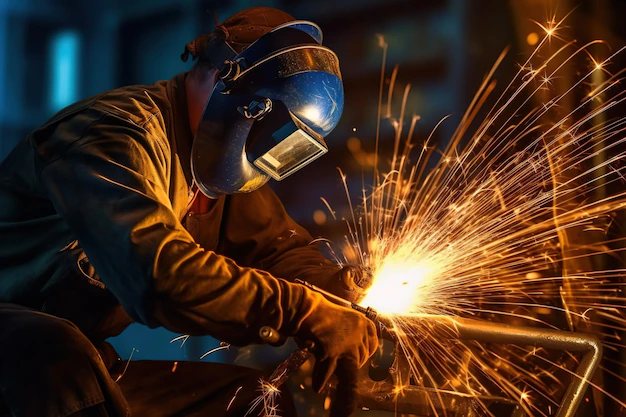Welding for Beginners | Mastering the Art of Metal Fusion

Introduction
Are you interested in metals and ready to learn about welding, which combines high heat and creativity? If such conditions apply, you may have come to the right place. This detailed guidebook is” Welding for Beginners.”When welding fuses metals to make anything from simple repairs to elaborate sculptures, it combines practical skills with creative expression.
This book helps people achieve their goals, whether they want to manage home activities or weld professionally. I will cover welding basics in the following parts, starting with safety rules. After that, an examination will cover welding processes, help choose tools, and offer a thorough guide to learning basic and advanced methods. After reading this thorough book, readers will have the knowledge and confidence to start welding. A blank canvas for creativity, liquid metal may be used for art. Start this wonderful trip for beginners and kindle your enthusiasm for welding.
Understanding the Basics of Welding for Beginners
the method of joining metal components using heat. Assume you have a pair of metals that you want to bond permanently. This is where welding comes into play. The metal is first heated until it is very hot—hotter than a summer day in the desert—and then it is cooled. The elevated temperature causes the metal to transition phase, resulting in a malleable and dense state. Subsequently, a specialized apparatus known as a welding torch is used to liquefy the peripheries of the metallic components thermally.
Once they undergo the cooling process, they exhibit a robust adhesive property, surpassing conventional glue. The method may be likened to metallurgical sorcery, when two distinct entities are seamlessly fused, forming a cohesive one. Welding is widely used in constructing many objects, including automobiles, architectural structures, artistic artworks, and even aerospace vehicles. This talent may be advantageous since it is accessible to individuals of all backgrounds via appropriate training and diligent practice.
Why Learn Welding?

- Indeed, the following are strong reasons why learning how to weld is an undertaking that should be pursued:
- The ability to weld is quite adaptable and may be used in various fields, ranging from the building trade to the creative arts.
- Opportunities for Employment There is a significant need for skilled welders, which results in good employment opportunities and room for professional advancement.
- Learning to weld allows you to handle do-it-yourself jobs around the house, which may save you money on home repairs and renovations.
- Welding paves the way for artistically inclined individuals to create one-of-a-kind sculptures and works of art using metal.
- Welding allows you to create something from scratch with your own two hands, which is a very satisfying activity in and of itself.
- Welding is an intellectually exciting discipline because it requires analytical reasoning and finding solutions to issues.
- Welders are essential in constructing various physical structures, from skyscrapers and bridges to pipelines and industrial facilities.
- Welders often get pay comparable to those of other tradespeople, and their earning potential may considerably grow as they gain experience in the field.
- Welding is a fundamental process that underpins all other technical developments, including those in the aerospace, automotive, and other industries.
- You will become more independent if you learn to weld since you can repair and construct metal products without the assistance of others.
Safety First: Protective Gear
- When working with welding equipment, safety must be your first concern. Ensure that you have all of the following pieces of protection equipment before you start your first arc:
- Welding Helmet: Wearing a welding helmet will shield the eyes from the harsh light and ultraviolet rays generated by the welding process.
- Welding gloves protect the wearer from flames and hot metal at high temperatures.
- Jacket for Welding: A flame-resistant jacket protects your upper body from burns and splatter while welding.
Welding Equipment
Here are ten essential welding equipment items:
- Welding Machine
- Welding Helmet
- Welding Gloves
- Welding Jacket
- Welding Electrodes
- Welding Wire
- Welding Shield or Screen
- Chipping Hammer
- Wire Brush
- Welding Clamps
Preparing Your Workspace
Here are seven crucial welding workstation preparation steps:
- Breathe out welding fumes to avoid inhaling hazardous gases.
- Set up a robust and level workstation for welding jobs.
- Remove debris, explosive objects, and tripping hazards from the workstation.
- Keep one handy for unexpected fires.
- Proper illumination is essential for welding vision.
- Maintain your power supply and extension cables to avoid electrical risks.
- Wear your welding helmet, gloves, and jacket for safety before welding.
Types of welding
There are several methods of welding. However, as a novice, you should concentrate on the following three:
MIG Welding (MIG Welding)
The welding technique, MIG (Metal Inert Gas), is famous for its ease of use and adaptability. Because of how simple it is, it is a good option for those who are just starting.
Welding using a TIG Torch
The welding technique known as TIG (Tungsten Inert Gas) provides exact control, making it an excellent choice for joining delicate materials and complex structures.
Welding Using a Stick
Shielded Metal Arc Welding (SMAW), another name for stick welding, is a flexible procedure that works well in various situations. Because of this, it is an excellent option for welding in the open air.
Setting Up Your Welder
- Indeed, the following are procedures to be followed to set up your welder:
- Select the Suitable Welding Process. Pick the welding method that is most suitable for the completion of the work, whether it be stick welding, MIG welding, or TIG welding.
- Check the Power Supply. Ensure that your workspace’s electricity source and voltage suit the welding equipment you want to use.
- Check the welding connections for any signs of harm or wear, and double-check that they are correctly attached to the machine.
- Choose an electrolyte or welding wire explicitly designed for the metal you work with.
- Adjust the parameters on the welding machine to correspond with the material density and the welding process. These settings include the voltage, the amperage, and the wire speed.
- If you use MIG or TIG welding, examine the gas supply and ensure it is connected correctly. If you are using TIG welding, check the gas supply as well.
- Securely attach the ground clamp to the workpiece or the worktable, ensuring a clean metal-to-metal connection.
- Put on your protective equipment, such as a welding helmet, protective gloves, and clothing covering your arms and legs.
- Strikes for Practice: You should get some practice striking an arc or starting the welding process a few times on a piece of scrap metal to acquire a feel for how the process works.
- Verify All Settings Before You Start Welding On Your Actual Project Before welding on your project, you should verify all settings, safety measures, and connections to guarantee a successful and safe welding operation.
Welding Techniques
Here are crucial welding procedures:
- Manage the arc and prevent overheating by keeping the electrode and workpiece apart.
- Maintain a consistent pace for solid and uniform welds—too quick causes partial penetration, while too sluggish cause excessive heat.
- To correctly manage the weld pool and penetrate, maintain the electrode angle around 15-20 degrees.
- Sharpen and clean joint edges for fusing and penetration.
- For varied project requirements, master flat, horizontal, vertical, and overhead welding positions.
- Tack welds hold workpieces in place before final welding to ensure alignment.
- Weld joint portions in sequence to minimize deformation and maintain structural integrity.
- Control the temperature between passes to avoid heat buildup, especially in thick materials.
- Multi-pass welding requires backstepping to distribute heat and reduce fractures uniformly.
- To ensure quality and safety, examine welds after completion.
Welding Tips for Beginners
Without a doubt, listed below are helpful hints for novice welders presented in bullet point form:
- Make time in your schedule to work on your welding skills regularly so that you may hone your technique and boost your self-assurance.
- First and foremost, safety should never be compromised. Always ensure you operate in an area with adequate ventilation and use the proper protection gear.
- Start with these straightforward welding tasks to gain experience before moving on to more difficult tasks.
- Feel free to seek the guidance of seasoned welders or enroll in welding seminars to learn from industry professionals.
- To improve your welding ability, carefully diagnose any issues that arise throughout the welding process, such as porosity or uneven beads, and then implement the necessary corrections.
Conclusion
Finally, “welding for beginners” opens doors to innovation, craftsmanship, and profitable careers. This in-depth tutorial has given you the basics to start welding. Safety and practice are essential to perfecting any art. You’ll love turning raw metal into practical constructions or detailed artwork as you practice. Keep your curiosity and love for welding alive, whether you weld as a pastime or professionally. Wear your welding helmet and let the flames fly as you explore this fantastic world of welding. Start your trip today, and the opportunities are endless.
FAQs
How hot does a welding arc get?
Welding arcs can reach 6,500 degrees Fahrenheit (3,600 degrees Celsius), making proper protective gear crucial.
Can I weld at home safely?
You can weld safely at home by following safety precautions, having the right equipment, and practicing in a well-ventilated area.
What metals can I weld together?
The ability to weld different metals together depends on their compatibility. Research the specific metals and welding processes for best results.
Is welding challenging to learn?
Welding requires practice and patience, but anyone can learn to weld effectively with dedication.
What are some common welding mistakes to avoid?
Common welding mistakes include improper electrode angle, inadequate cleaning of the joint, and incorrect travel speed. Always follow best practices to avoid these errors.






